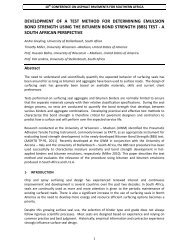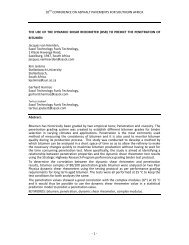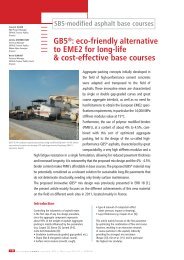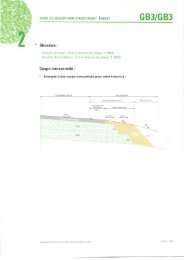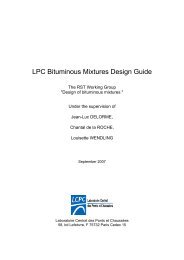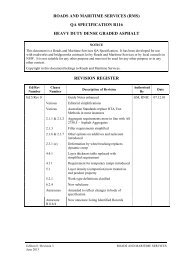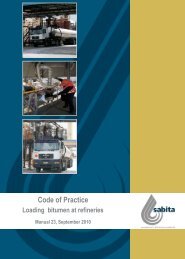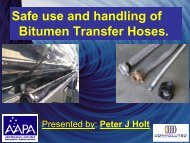Guide to the safe handling of solvents in a bituminous ... - Aapaq.org
Guide to the safe handling of solvents in a bituminous ... - Aapaq.org
Guide to the safe handling of solvents in a bituminous ... - Aapaq.org
- No tags were found...
Create successful ePaper yourself
Turn your PDF publications into a flip-book with our unique Google optimized e-Paper software.
• The use <strong>of</strong> High Performance Liquid Chroma<strong>to</strong>graphy (HPLC), GasChroma<strong>to</strong>graphy (GC) or Th<strong>in</strong> Layer Chroma<strong>to</strong>graphy (TLC) <strong>to</strong>characterise <strong>the</strong> chemical composition <strong>of</strong> bitumen;• The Dean and Starke test for <strong>the</strong> determ<strong>in</strong>ation <strong>of</strong> b<strong>in</strong>der content <strong>of</strong>bitumen emulsions or water content <strong>of</strong> bitum<strong>in</strong>ous mixtures;• The determ<strong>in</strong>ation <strong>of</strong> <strong>the</strong> s<strong>of</strong>ten<strong>in</strong>g po<strong>in</strong>t <strong>of</strong> bitumen where <strong>the</strong>s<strong>of</strong>ten<strong>in</strong>g po<strong>in</strong>t is expected <strong>to</strong> exceed 85 o C.Best practice for any bitum<strong>in</strong>ous labora<strong>to</strong>ry would be <strong>to</strong> elim<strong>in</strong>ate <strong>the</strong> use <strong>of</strong><strong>solvents</strong> al<strong>to</strong>ge<strong>the</strong>r for all test methods, as well as for clean<strong>in</strong>g purposes.Advances <strong>in</strong> labora<strong>to</strong>ry equipment over <strong>the</strong> last decade have made this aviable option for some test methods, such as <strong>the</strong> determ<strong>in</strong>ation <strong>of</strong> b<strong>in</strong>dercontent, as well as for certa<strong>in</strong> clean<strong>in</strong>g requirements.However, it is not always possible <strong>to</strong> elim<strong>in</strong>ate <strong>the</strong> use <strong>of</strong> <strong>solvents</strong>al<strong>to</strong>ge<strong>the</strong>r. Under <strong>the</strong>se circumstances, <strong>the</strong> follow<strong>in</strong>g approach isrecommended:• The substitution <strong>of</strong> more hazardous <strong>solvents</strong> with lesshazardous <strong>solvents</strong> - A number <strong>of</strong> test method developments over<strong>the</strong> last decade have allowed for <strong>the</strong> validation <strong>of</strong> exist<strong>in</strong>g testmethods by replac<strong>in</strong>g un<strong>safe</strong> <strong>solvents</strong> such as tricholorethylene (TCE)with "<strong>safe</strong>r" solvent comb<strong>in</strong>ations such as <strong>to</strong>luene/ethanol (85/15) orblends <strong>of</strong> n-propylbromide (1-bormopropane). The word "<strong>safe</strong>r" isplaced <strong>in</strong> quotation marks as it is important for any opera<strong>to</strong>r <strong>in</strong> alabora<strong>to</strong>ry <strong>to</strong> understand that no solvent is completely <strong>safe</strong>. Even for"<strong>safe</strong>" <strong>solvents</strong>, <strong>the</strong>re will always be some labora<strong>to</strong>ry opera<strong>to</strong>rs whowould be sensitised <strong>to</strong> such <strong>solvents</strong>, whe<strong>the</strong>r through a medical <strong>org</strong>enetic predisposition;• The substitution <strong>of</strong> more hazardous <strong>solvents</strong> with one <strong>of</strong> <strong>the</strong>new generation "non-<strong>to</strong>xic", environmentally friendly <strong>solvents</strong> -These new generation <strong>solvents</strong>, based on blends <strong>of</strong> naturallyoccurr<strong>in</strong>g compounds (eg limonene blends <strong>of</strong> oils derived from lemonpeels) are easier <strong>to</strong> dispose <strong>of</strong> and are generally biodegradable;• M<strong>in</strong>imis<strong>in</strong>g risk exposure - Where it is not practical <strong>to</strong> replace ahazardous solvent, it is important, depend<strong>in</strong>g on <strong>the</strong> <strong>to</strong>xicity <strong>of</strong> <strong>the</strong>solvent as well as legislative requirements, that <strong>the</strong> requiredmeasures <strong>to</strong> m<strong>in</strong>imise risk exposure for a labora<strong>to</strong>ry opera<strong>to</strong>r beundertaken. Such risk management (even for less <strong>to</strong>xic <strong>solvents</strong>)would entail:8



